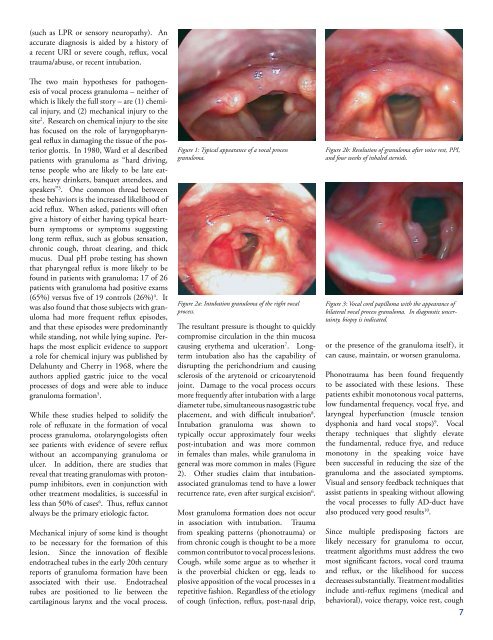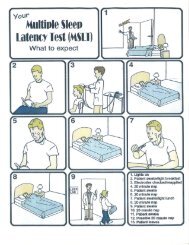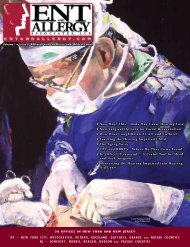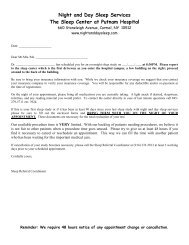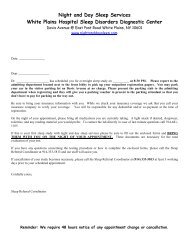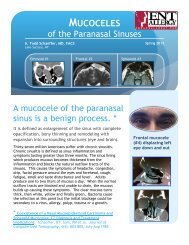A Royal Pain in the Throat Tinnitus - ENT & Allergy Associates
A Royal Pain in the Throat Tinnitus - ENT & Allergy Associates
A Royal Pain in the Throat Tinnitus - ENT & Allergy Associates
- No tags were found...
You also want an ePaper? Increase the reach of your titles
YUMPU automatically turns print PDFs into web optimized ePapers that Google loves.
(such as LPR or sensory neuropathy). Anaccurate diagnosis is aided by a history ofa recent URI or severe cough, reflux, vocaltrauma/abuse, or recent <strong>in</strong>tubation.The two ma<strong>in</strong> hypo<strong>the</strong>ses for pathogenesisof vocal process granuloma – nei<strong>the</strong>r ofwhich is likely <strong>the</strong> full story – are (1) chemical<strong>in</strong>jury, and (2) mechanical <strong>in</strong>jury to <strong>the</strong>site 2 . Research on chemical <strong>in</strong>jury to <strong>the</strong> sitehas focused on <strong>the</strong> role of laryngopharyngealreflux <strong>in</strong> damag<strong>in</strong>g <strong>the</strong> tissue of <strong>the</strong> posteriorglottis. In 1980, Ward et al describedpatients with granuloma as “hard driv<strong>in</strong>g,tense people who are likely to be late eaters,heavy dr<strong>in</strong>kers, banquet attendees, andspeakers” 3 . One common thread between<strong>the</strong>se behaviors is <strong>the</strong> <strong>in</strong>creased likelihood ofacid reflux. When asked, patients will oftengive a history of ei<strong>the</strong>r hav<strong>in</strong>g typical heartburnsymptoms or symptoms suggest<strong>in</strong>glong term reflux, such as globus sensation,chronic cough, throat clear<strong>in</strong>g, and thickmucus. Dual pH probe test<strong>in</strong>g has shownthat pharyngeal reflux is more likely to befound <strong>in</strong> patients with granuloma; 17 of 26patients with granuloma had positive exams(65%) versus five of 19 controls (26%) 4 . Itwas also found that those subjects with granulomahad more frequent reflux episodes,and that <strong>the</strong>se episodes were predom<strong>in</strong>antlywhile stand<strong>in</strong>g, not while ly<strong>in</strong>g sup<strong>in</strong>e. Perhaps<strong>the</strong> most explicit evidence to supporta role for chemical <strong>in</strong>jury was published byDelahunty and Cherry <strong>in</strong> 1968, where <strong>the</strong>authors applied gastric juice to <strong>the</strong> vocalprocesses of dogs and were able to <strong>in</strong>ducegranuloma formation 5 .While <strong>the</strong>se studies helped to solidify <strong>the</strong>role of refluxate <strong>in</strong> <strong>the</strong> formation of vocalprocess granuloma, otolaryngologists oftensee patients with evidence of severe refluxwithout an accompany<strong>in</strong>g granuloma orulcer. In addition, <strong>the</strong>re are studies thatreveal that treat<strong>in</strong>g granulomas with protonpump<strong>in</strong>hibitors, even <strong>in</strong> conjunction witho<strong>the</strong>r treatment modalities, is successful <strong>in</strong>less than 50% of cases 6 . Thus, reflux cannotalways be <strong>the</strong> primary etiologic factor.Mechanical <strong>in</strong>jury of some k<strong>in</strong>d is thoughtto be necessary for <strong>the</strong> formation of thislesion. S<strong>in</strong>ce <strong>the</strong> <strong>in</strong>novation of flexibleendotracheal tubes <strong>in</strong> <strong>the</strong> early 20th centuryreports of granuloma formation have beenassociated with <strong>the</strong>ir use. Endotrachealtubes are positioned to lie between <strong>the</strong>cartilag<strong>in</strong>ous larynx and <strong>the</strong> vocal process.Figure 1: Typical appearance of a vocal processgranuloma.Figure 2a: Intubation granuloma of <strong>the</strong> right vocalprocess.The resultant pressure is thought to quicklycompromise circulation <strong>in</strong> <strong>the</strong> th<strong>in</strong> mucosacaus<strong>in</strong>g ery<strong>the</strong>ma and ulceration 7 . Longterm<strong>in</strong>tubation also has <strong>the</strong> capability ofdisrupt<strong>in</strong>g <strong>the</strong> perichondrium and caus<strong>in</strong>gsclerosis of <strong>the</strong> arytenoid or cricoarytenoidjo<strong>in</strong>t. Damage to <strong>the</strong> vocal process occursmore frequently after <strong>in</strong>tubation with a largediameter tube, simultaneous nasogastric tubeplacement, and with difficult <strong>in</strong>tubation 8 .Intubation granuloma was shown totypically occur approximately four weekspost-<strong>in</strong>tubation and was more common<strong>in</strong> females than males, while granuloma <strong>in</strong>general was more common <strong>in</strong> males (Figure2). O<strong>the</strong>r studies claim that <strong>in</strong>tubationassociatedgranulomas tend to have a lowerrecurrence rate, even after surgical excision 6 .Most granuloma formation does not occur<strong>in</strong> association with <strong>in</strong>tubation. Traumafrom speak<strong>in</strong>g patterns (phonotrauma) orfrom chronic cough is thought to be a morecommon contributor to vocal process lesions.Cough, while some argue as to whe<strong>the</strong>r itis <strong>the</strong> proverbial chicken or egg, leads toplosive apposition of <strong>the</strong> vocal processes <strong>in</strong> arepetitive fashion. Regardless of <strong>the</strong> etiologyof cough (<strong>in</strong>fection, reflux, post-nasal drip,Figure 2b: Resolution of granuloma after voice rest, PPI,and four weeks of <strong>in</strong>haled steroids.Figure 3: Vocal cord papilloma with <strong>the</strong> appearance ofbilateral vocal process granuloma. In diagnostic uncerta<strong>in</strong>ty,biopsy is <strong>in</strong>dicated.or <strong>the</strong> presence of <strong>the</strong> granuloma itself), itcan cause, ma<strong>in</strong>ta<strong>in</strong>, or worsen granuloma.Phonotrauma has been found frequentlyto be associated with <strong>the</strong>se lesions. Thesepatients exhibit monotonous vocal patterns,low fundamental frequency, vocal frye, andlaryngeal hyperfunction (muscle tensiondysphonia and hard vocal stops) 9 . Vocal<strong>the</strong>rapy techniques that slightly elevate<strong>the</strong> fundamental, reduce frye, and reducemonotony <strong>in</strong> <strong>the</strong> speak<strong>in</strong>g voice havebeen successful <strong>in</strong> reduc<strong>in</strong>g <strong>the</strong> size of <strong>the</strong>granuloma and <strong>the</strong> associated symptoms.Visual and sensory feedback techniques thatassist patients <strong>in</strong> speak<strong>in</strong>g without allow<strong>in</strong>g<strong>the</strong> vocal processes to fully AD-duct havealso produced very good results 10 .S<strong>in</strong>ce multiple predispos<strong>in</strong>g factors arelikely necessary for granuloma to occur,treatment algorithms must address <strong>the</strong> twomost significant factors, vocal cord traumaand reflux, or <strong>the</strong> likelihood for successdecreases substantially. Treatment modalities<strong>in</strong>clude anti-reflux regimens (medical andbehavioral), voice <strong>the</strong>rapy, voice rest, cough7


